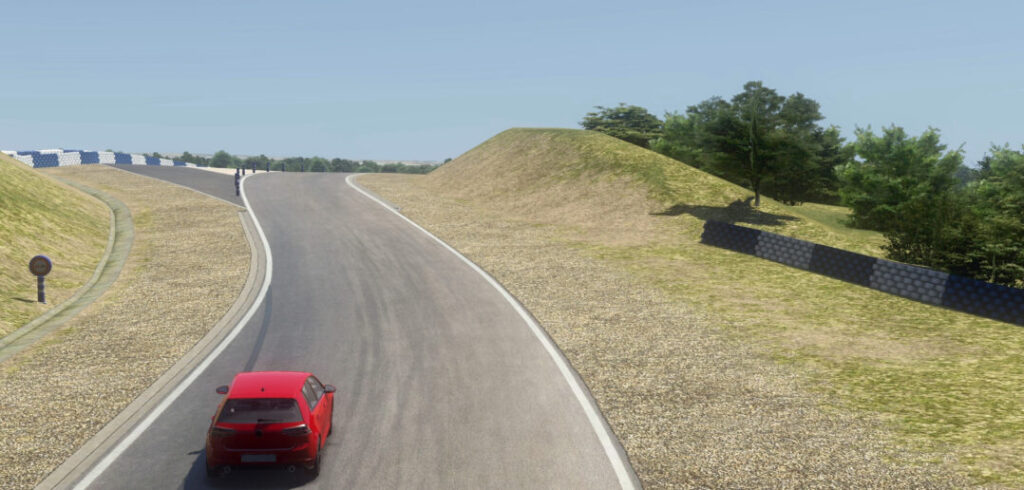UK driving simulation software specialist rFpro has developed a virtual model of Applus Idiada’s proving ground. The digital twin enables the evaluation of systems and vehicles in a fully representative virtual environment both before and after physical prototypes are available for validation on the track, helping manufacturers speed the overall vehicle development process.
The digital twin of Applus Idiada’s Dry Handling Circuit is the latest addition to its library of engineering-grade digital driving environments, which it says is the world’s largest. The library includes proving grounds, test tracks and hundreds of kilometres of varying real roads, as well as almost every major motor racing circuit in the world. The Idiada Dry Handling Circuit is available immediately, followed by the High Speed Circuit from September and the General Road Circuit by the end of the year.
“Virtual simulation is becoming increasingly important in vehicle development. It speeds up and reduces the cost of development, whilst also allowing a wider range of parameters to be explored in complete safety,” said Peter Daley, MD, rFpro.
“From our experience supporting many of the world’s leading professional motorsport teams, we see the value of simulation in terms of vehicle dynamic performance. In the wider automotive world, the ride and handling feel of a car is more important than out and out lap times, but the use of simulation is just as relevant. For ADAS and autonomous driving systems, virtual simulation has a vital role to play in exposing systems to the massive range and volume of scenarios which could be encountered on the road. In all cases, it is essential that virtual simulations are validated against real-world results. The world-renowned Applus Idiada proving ground provides a perfect environment in which to do this.”
In order to be effective as a development tool, simulation must correlate accurately with the real world. A key element of rFpro’s solution is its TerrainServer software that enables a high-definition road-surface simulation to be delivered to each wheel of the vehicle independently. By utilising the highest accuracy laser scanning survey data and a volumetric tyre-road interaction, it captures detailed surface information that is missed by point-based sampling methods, according to the company. TerrainServer models correlate with the actual road surfaces used during ‘real-world’ testing with an accuracy of around 1mm in Z (height) at a resolution of 1cm in X and Y (position).
“The road surface modeling is so accurate and the correlation between simulation and the real world so good that we are able to extend the use of digital models into Vehicle Dynamics applications,” noted Sebastien Hoppenot, Applus Idiada test driver. “The dry handling circuit is a great combination of long quick corners, medium-speed chicanes and undulating turns, which is accurately brought to life in the simulator. It is the perfect place to assess aspects of vehicle dynamics, such as understeer/oversteer balance, steering feedback, rear axle stability and yaw damping.”
“By investing in highly accurate digital models, we can become an integrated part of our customers’ software development tool-chain,” added Javier Gutierrez, Applus Idiada product coordinator, vehicle dynamics and digital environments. “It helps to reduce development and validation time, and also to make the most of their time spent at our track here in Spain. With a consistent climate and a challenging array of circuits, Idiada is an ideal location to develop chassis dynamics and other vehicle technologies.”
rFpro’s software provides the industry’s widest range of application interfaces, for example to vehicle and traffic modeling software as well as driving simulation platforms. The digital models created by rFpro can be populated by ego vehicles (the customer’s vehicles) as well as by semi-intelligent ‘swarm’ traffic and programmed traffic. In rFpro’s virtual world, vehicular and pedestrian traffic can share the road network, whether following pre-determined rules of the road or being controlled to act in a way which creates hazards and provokes responses from other participants. This allows digital experiments to precisely mirror the physical tests conducted on the proving ground, for example with robotic soft-targets.
Complementing the high-fidelity surface modeling, rFpro also uses exceptionally high-quality, realistic graphics rendering, up to 32bit HDR, which is not only important for driver immersion, but also essential for the training, testing and validation of deep-learning based ADAS and autonomous systems.
Within the new circuit models, even the lighting is modeled accurately for Applus Idiada’s latitude and longitude, and will adjust automatically according to user-defined settings for the day of the year, time of day, atmospheric and weather conditions. Circumstances, such as the transition between poorly-lit and well-lit areas, the effect of the sun low in the sky or the approaching headlights of oncoming vehicles, are all faithfully reproduced.


